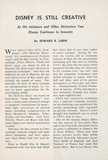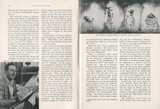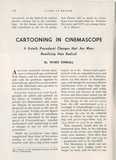Walt Disney's first Silly Symphony (The Skeleton Dance, 1959), his monumental Fantasia (1940), and his first cartoon in CinemaScope (Toot, Whistle, Plunk and Boom, 1953), can almost be said to illustrate the three major advances in animation techniques. And they can definitely be said to illustrate the use and improvement of film sound, particularly the sounds of music. For, basically, all three of these cartoons are interpretations of music, i.e., lessons in music appreciation for the moviegoing public.
The Skeleton Dance was based on Saint-Saens' "Danse Macabre." Fantasia – a much more advanced attempt at animated visualizations of music – used eight selections of classical music, including compositions of Bach, Beethoven, Schubert, Tchaikowsky and Stravinsky. And Toot, Whistle, Plunk and Boom tells how music began and musical instruments evolved.
This last, the first cartoon in CinemaScope, contains simpler and more direct animation, and freer caricature, than Disney had ever used before.
Prior to World War II Disney's animation style was head and shouldens above that of any other maker of movie cartoons. During the war years his studio did an enormous amount of films for the government (including such fine ones as Chicken Little). But after the war many critics promoted the idea that the characters in his cartoons were "too cute" and that his animation techniques were hybrid attempts to repeat, with less skill and effort, such of his pre-war masterpieces as Pinocchio and Dumbo. Simultaneously, United Productions of America (UPA) introduced a new animation formula – less expensive, more sophisticated.
UPA's less expensive techniques were a post-war economic necessity, for sky-rocketing costs prohibited the careful, painstaking work expended on pre-war cartoons. Disney's critics thought him foolhardy not to switch to UPA's style at once.
One of the reasons Disney didn't was his interest in live-action films and in his True-Life Adventure Series (as great a milestone in Disney's life as Snow White). There had been many nature study films before Disney's True-Life Adventure Series. Percy Smith in England, and Jean Painleve in France had made fine nature films. But it was Disney who first put over this type of movie in a new, effective, commercially successful way.
[…]


